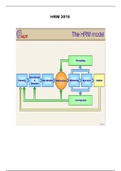HRM 2018
,Chapter 1 Strategic Human Resource Management in the 21st Century
Human resource management: employees matter and the management of
employees (human resource management) is a potential source for achieving
organizational goals.
Why is it important for you?
- Because everything that you do/change in an organization will have some
effect on employees and on the relationship between employer and
employees.
Organizational change and competitive advantage
The relevance of optimal coping with change is embedded in the concept of
competitive advantage. Competitive advantage represents an organization’s position
in comparison to its direct competitors.
The concept of competitive advantage represents a relative outcome:
‘An organization with competitive advantage is doing better than its competitors
irrespective of the actual firm performance (negative or positive). In the case of
losses, the organization is still doing better than its competitors. And in the case of
profits, the organization makes more profits than the others.’
MHRM, IHRM and SHRM
HRM involves management decisions related to policies and practices that together
shape the employment relationship and are aimed at achieving individual,
organizational and societal goals. There are three major sub-fields of HRM:
1. Micro HRM - MHRM: covers the sub-functions of human resource policy and
practice, including recruitment and selection, induction and socialization, and
training and development. It is closely related to the studies in organizational
behavior and occupational psychology that focus on the impact of single HR
practices on employee attitudes and behaviours.
2. International HRM - IHRM: is concerned with HRM in MNCs and HRM across
borders. If focuses on issues such as the transferability of HR practices across
business units in different countries, the optimal management of expatriates
and the impact of different institutional country contexts on HRM.
3. Strategic HRM - SHRM: focuses on issues linking HRM to the business
strategy, designing high-performance work systems and adding value through
good people management in an attempt to gain sustained competitive
advantage. The concept of ‘fit’ plays an central role within SHRM.
,Stakeholders of an organization represent all groups inside and outside an
organization that can affect its strategy and goals.
Internal stakeholders include employees, line managers, top management and
employee representatives.
External stakeholders include shareholders, financiers, trade unions, national
government, local government and other interest groups (Greenpeace).
Three perspectives
The multidimensional strategic HR model in this includes the following key
characteristics:
1. A multi-actor perspective (multiple stakeholders, including employees,
managers, HR professionals, work councils, trade unions, top management,
shareholders, financiers and government).
2. A broad societal view: with an emphasis on different institutional contexts, for
example on the level of branches of industry, regions and countries.
3. A multi-level perspective: including the individual employee perspective and
the strategic organizational perspective.
The employment relationship contains different contract types:
1. Legal contract: mostly written down. Determines the rights and obligations of
both the employee and the organization.
2. Economic or transactional contract: determines how much the employer will
pay for the employee’s efforts, for example in terms of salary.
3. Psychological contract: concerning all things that are not written down but are
expected from both actors (employee and organization).
4. Sociological contract: represents the social relationships employees have with
each other.
Traditionally, a distinction is made between the Anglo-Saxon or Anglo-American
models and the Rhineland models.
The Anglo-American approaches in IR and HRM, for example in the USA, mainly
focus on creating shareholder value in terms of profits and market value with little or
no attention to other stakeholders including trade unions and works councils.
In contrast, the Rhineland models, acknowledge multiple stakeholders and their
interests explicitly taking into account employee interests in terms of well-being and
societal interests.
, Stakeholder Illustrations of their interests Level
Shareholders High profits, growth and Strategic organization level
increased market value
Employees Security, fun, meaningful Individual employee level
work, development and
challenges
Managers Productivity, quality, Team and departmental
innovations and status level
Top management Reputation, shareholder Strategic organization level
value and long-term
success
Work councils Employment security and Strategic organization level
good working conditions and individual employee
level
Trade unions Employment, fairness and Strategic organization level
good working conditions and individual employee
level
Financiers Return on investment and Strategic organization level
financial health of the
organization
Local government Employment and Strategic organization level
environmental pollution
National government Labour legislation and Strategic organization level
societal legitimacy
Other interest groups Environmental pollution Strategic organization level
Suppliers Reliability Strategic organization level
Customers Costs, quality and All levels
innovation
The table above presents an overview of the different possible stakeholders of an
organization, their potential interests and the level of analysis with regard to the
shaping of the employment relationship.
Balanced Approach
In the strategic balance model, organizational success can only be achieved when
financial performance AND societal performance of an organization are above
average in the particular population in which the organization is operating.
The definition of ‘good’ and ‘bad’ people management can be linked to the balanced
approach. Taking into account multiple stakeholders interests and a broader societal
view in the design of the employment relationship in an organization is likely to result
in ‘good’ people management. From this point of view, it means that using a narrow
and unitarist perspective (for example, only serving the interests of the shareholders)
is likely to result in ‘bad’ people management.





